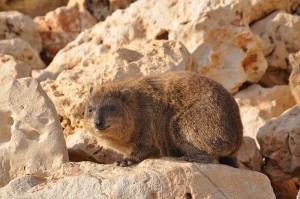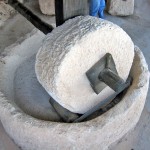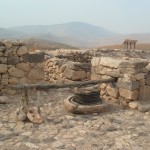
This little animal is happily perched on one of the scariest cliffs in Israel. (Hyrax in Rosh Haniqra)
This Post is a cunning combination of this weeks Torah Portion (Re’eh) and the Monthly Spotlight on Nature.
‘But this you can’t eat… the Camel, the Hare and the Hyrax’.(Deuteronomy / Devarim 14:7)
Not a Badger or a Rabbit
A little note (or rant) on my translation and what animals you can actually expect to see in Israel. The King James translation of the Bible renders this the ‘Camel, the hare and the coney’. This is patently ridiculous as ‘Coney’ means a rabbit.
Exciting Nature Fact of the Day: THERE ARE NO WILD RABBITS IN ISRAEL.
The Bible was written for a people intended to live in the land of Israel. The fauna spoken of in the Bible are all animals indigenous to Israel. As there are no naturally occuring wild Rabbits in Israel. Some translations such as the ‘New American’ translate the second animal, in hebrew ‘Arnevet’, as rabbit too. This is equally wrong even though in modern Hebrew a similar word ‘Arnav’ means rabbit and ‘Arnevet’ means lady rabbit.
Exciting Nature Fact of the Day number 2:
THERE ARE NO BADGERS EITHER.
All the translations that call ‘Shaphan’ (the last animal) a badger are clearly mistaken, there are no badgers in Israel at all.
Common Israeli anmals
The first animal mentioned ‘Gamal’ in hebrew is easy to translate and spot, there are, suprisingly enough, quite a lot of camels in this part of the world.
The second animal; ‘Arnevet’, well I have n’t yet seen a hare in Israel, but apparently there are quite a number.
(Oh yes, incidentally the difference between a Rabbit and a Hare is that Hares are non gregarious, they do n’t live in communities and they are larger than Rabbits.)
The third one, ‘Shaphan’, is a hyrax, the little fuzzy beast depicted above. They can be seen all over the place, in the desert in Ein Gedi, in the Galilee and up on the Coast at Rosh Haniqra. Psalm 104 describes them as hiding in rocks, and its pretty much a rule in Israel, anywhere there’s rocks, there’s bound to be a hyrax or two poking around.
(This Word of Torah is dedicted to the Health of Zlata bat Sima)



